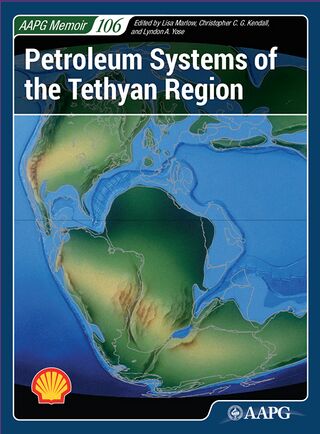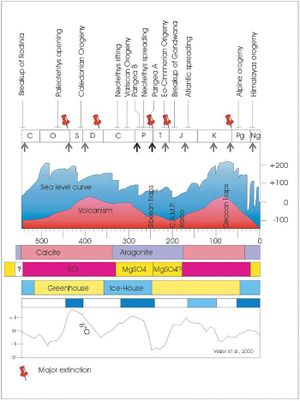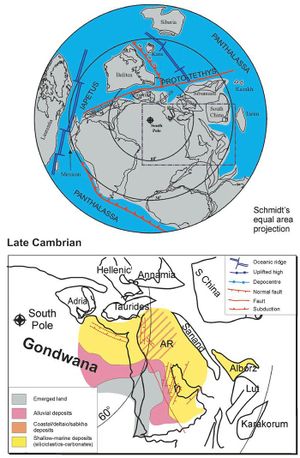Phanerozoic Tethys region
| Petroleum systems of the Tethyan region | |

| |
| Series | AAPG Memoir |
|---|---|
| Chapter | The evolution of the Tethys region throughout the Phanerozoic: A brief tectonic reconstruction |
| Author | Fabrizio Berra, Lucia Angiolini |
| Link | Web page |
| Store | AAPG Store |
The Tethyan region is a major petroleum province. The paleogeographic position and tectonic history is a major control on sedimentation across the region, and this has influenced the sequestration of hydrocarbons in the region. The North African-Arabian plate evolved along the Tethyan margins (Proto-Tethys, Paleo-Tethys, Neo-Tethys) from Pre-Cambrian to Recent.
Paleogeographic reconstructions
Paleogeographic maps have been reconstructed for selected time intervals: Cambrian, Late Ordovician, Early Devonian, Early Permian, Permian-Triassic boundary, Norian, Callovian, Aptian, Cretaceous-Cenozoic boundary, and Late Eocene. For each time interval both the general picture of the major plate tectonic configuration and a detail of the paleogeography and paleoenvironment of North Africa to the Middle East are presented. On these maps, the major paleoenvironmental settings (from continental to shallow marine and deep ocean) are shown for the area stretching from North Africa to Afghanistan in all the selected time slices. Besides the major tectonic events, the global climate evolution and their interplay are discussed, which in some cases led to significant biotic turnovers or even to mass extinctions (e.g., Late Ordovician, Permian-Triassic boundary, Cretaceous-Cenozoic boundary). Paleogeographic maps have been compiled from literature, selecting those based on sound paleomagnetic/paleobiogeographic data. Each map is accompanied by the description of the major tectonic events that characterized the considered time interval. When contrasting paleogeographic reconstructions were available, their differences have been discussed. In general, major differences concern the interpretation of the setting and positioning of the microplates and terranes between the major continental plates.

The paleogeography of the Earth during the Phanerozoic reflects the breakup of Rodinia and the formation of Pangea and its later breakup. Sedimentation was affected by the latitudinal position of the continents, the global climate conditions, and the seawater chemistry at the largest scale, and at the basin scale by the gradual changes in the local tectonic environment that accompanied the formation and destruction of the Tethyan oceans. Each global map is coupled with a more detailed map of North Africa and the Middle East. On these maps, the major depositional settings (emerged land, continental, shallow marine, and deep marine environments) are shown. These maps are a simplified view of the Western Tethys region, whereas the detailed facies distribution of the major domains is described in the chapters that follow in this book. The time-position of these paleogeographic maps is framed by the Phanerozoic history, so each map is viewed in the context of the evolution of the sea-water chemistry (aragonite vs. calcite sea, KCl vs. MgO4 evaporites), the global sea-level curve, the major volcanic events, the global climate, the major geodynamic events, and the age of the five major extinctions of the Phanerozoic (Figure 1). The interplay between these changing parameters is important as it controls and explains the distribution of climate belts (and thus the distribution of the climate-sensitive depositional environments), the depth and area of the submerged shelves, and the biogenic contribution to sediment production.

Cambrian (late Cambrian, about 500 Ma)
During Cambrian time (Figure 2) most of the continents were gathered in the southern hemisphere.[1] [3] Gondwana stretched from the equator (Australia) to the South Pole (North Africa). Tectonic movement was active mainly as a consequence of the relative rotation of the different cratons that built Gondwana.[4] Extensional tectonics that controlled the deposition of major evaporitic successions in the Arabic peninsula (Hormuz Salt Basin) and surroundings (e.g., Punjab Salt Basin) close to the Precambrian–Cambrian boundary (see dashed faults in Figure 2) came to an end, and no important tectonic activity is observed in the late Cambrian (500 Ma). Laurentia lay astride the equator in both hemispheres and was separated from Gondwana by the Iapetus Ocean. Avalonia, Armorica, Perunica, Baltica (180° geographically inverted), North and South China, and all the Cimmerian blocks fringed peripheral Gondwana at moderate to high southern latitudes. Torsvik and Cocks[3] show that South China was located close to the Equator. According to von Raumer and Stampfli,[5]d the Proto-Tethys ocean, which separated North China (to the north) from the other blocks along the peripheral Gondwana, was subducting toward the south and backarc extension, which is suggested by oceanic Cambrian seaways between the peripheral Gondwanan blocks. Torsvik and Cocks[3] recognized that their concept of the Ran Ocean used for the Cambrian-Ordovician ocean existing between Baltica and Gondwana is comparable to that of the Proto-Tethys (sensu Stampfli and Borel[2]), and herein we prefer to use the latter term. Siberia was positioned at low latitudes and was separated from Laurentia and Baltica by oceanic crust. Avalonia rifted off Gondwana in the Early Ordovician with the opening of the Rheic Ocean,[6] although some authors suggest even older ages for its opening.[3]
See also
References
- ↑ 1.0 1.1 Cocks, L. M. R., and Torsvik, T. K., 2002, Earth geography from 500 to 400 million years ago: A faunal and palaeomagnetic review: Journal of the Geological Society, v. 159, p. 631–644.
- ↑ 2.0 2.1 Stampfli, G. M., and Borel, G. D., 2002, A plate tectonic model for the Paleozoic and Mesozoic constrained by dynamic plate boundaries and restored synthetic oceanic isochrons: Earth and Planetary Science Letters, v. 196, p. 17–33.
- ↑ 3.0 3.1 3.2 3.3 Torsvik, T. H., and Cocks, L. R. M., 2009, The Lower Palaeozoic palaeogeographical evolution of the northeastern and eastern peri-Gondwanan margin from Turkey to New Zealand: GSL Special Publications, v. 325, p. 3–21.
- ↑ Veevers, J. J., 2004, Gondwanaland from 650-500 Ma assembly through 320 Ma merger in Pangea to 185-100 Ma breakup: Supercontinental tectonics via stratigraphy and radiometric dating: Earth-Science Reviews, v. 68, p. 1–132.
- ↑ von Raumer, J. F., and Stampfli, G. M., 2008, The birth of the Rheic Ocean - Early Palaeozoic subsidence patterns and subsequent tectonic plate scenarios: Tectonophysics, v. 461, p. 9–20.
- ↑ Nysæther, E., Torvik, T. H., Feist, R., Walderhaug, H. J., and Eide, E.A., 2002, Ordovician palaeogeography with new palaeomagnetic data from the Montagne Noire (Southern France): Earth and Planetary Science Letters, v. 203, p. 329–341.